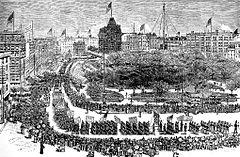Labor Day
From Wikipedia, the free encyclopedia
This article is about the holiday in the United States. For labor days in other parts of the world, see Labour Day. For the workers' holiday held on May 1, see International Workers' Day. For the 2013 American film, see Labor Day (film).
| Labor Day | ||
|---|---|---|

Labor Day Parade, Union Square, New York, 1882
|
||
| Observed by | United States | |
| Type | Federal Holiday (federal government, DC, and U.S. Territories); and State Holiday (in all 50 U.S. States) | |
| Celebrations | Parades, barbecues | |
| Date | First Monday in September | |
| 2013 date | September 2 | |
| 2014 date | September 1 | |
| 2015 date | September 7 | |
| 2016 date | September 5 | |
| Frequency | annual | |
| Related to | Labour Day | |
Labor Day was promoted by the Central Labor Union and the Knights of Labor, who organized the first parade in New York City. After the Haymarket Massacre, which occurred in Chicago on May 4, 1886, U.S. President Grover Cleveland feared that commemorating Labor Day on May 1 could become an opportunity to commemorate the affair. Thus, in 1887, it was established as an official holiday in September to support the Labor Day that the Knights favored.[1]
The equivalent holiday in Canada, Labour Day, is also celebrated on the first Monday of September. In many other countries (more than 80 worldwide), "Labour Day" is synonymous with, or linked with, International Workers' Day, which is observed on May 1.
Contents
History
In 1882, Matthew Maguire, a machinist, first proposed the holiday while serving as secretary of the CLU (Central Labor Union) of New York.[2] Others argue that it was first proposed by Peter J. McGuire of the American Federation of Labor in May 1882,[3] after witnessing the annual labour festival held in Toronto, Canada.[4] Oregon was the first state to make it a holiday on February 21, 1887. By the time it became a federal holiday in 1894, thirty states officially celebrated Labor Day.[3]Following the deaths of a number of workers at the hands of the U.S. military and U.S. Marshals during the Pullman Strike, the United States Congress unanimously voted to approve rush legislation that made Labor Day a national holiday; President Grover Cleveland signed it into law a mere six days after the end of the strike.[5] The September date originally chosen by the CLU of New York and observed by many of the nation's trade unions for the past several years was selected rather than the more widespread International Workers' Day because Cleveland was concerned that observance of the latter would be associated with the nascent socialist and anarchist movements that, though distinct from one another, had rallied to commemorate the Haymarket Affair in International Workers' Day.[6][7] All U.S. states, the District of Columbia, and the territories have made it a statutory holiday.
Pattern of celebration
The form for the celebration of Labor Day was outlined in the first proposal of the holiday: A street parade to exhibit to the public "the strength and esprit de corps of the trade and labor organizations",[2] followed by a festival for the workers and their families. This became the pattern for Labor Day celebrations. Speeches by prominent men and women were introduced later, as more emphasis was placed upon the civil significance of the holiday. Still later, by a resolution of the American Federation of Labor convention of 1909, the Sunday preceding Labor Day was adopted as Labor Sunday and dedicated to the spiritual and educational aspects of the Labor movement.[2]The holiday often marks the return to school, although school starting times now vary.
Retail Sale Day
To take advantage of large numbers of potential customers free to shop, Labor Day has become an important sale weekend for many retailers in the United States. Some retailers claim it is one of the largest sale dates of the year, second only to the Christmas season's Black Friday.[8]Ironically, because of the importance of the sale weekend, some of those who are employed in the retail sector not only work on Labor Day, but work longer hours. More Americans work in the retail industry than any other, with retail employment making up 24% of all jobs in the United States.[9] As of 2012, only 3% of those employed in the retail sector were members of a labor union.[9]
In high society, Labor Day is (or was) considered the last day of the year when it is fashionable to wear white[10] or seersucker.[11][12]
In U.S. sports, Labor Day marks the beginning of the NFL and college football seasons. NCAA teams usually play their first games the weekend of Labor Day, with the NFL traditionally playing their first game the Thursday following Labor Day. The Southern 500 NASCAR auto race was held that day from 1950 to 1983 in Darlington, South Carolina. At Indianapolis Raceway Park, the National Hot Rod Association hold their finals to the U.S. Nationals drag race. Labor Day is the middle point between weeks 1 and 2 of the U.S. Open Tennis Championships held in Flushing Meadows, New York.
In the United States, many school districts resume classes around the Labor Day holiday weekend (see First Day of School). Most begin the week before, making Labor Day weekend the first three-day weekend of the school calendar, while others return the Tuesday following Labor Day, allowing families one final getaway before the school year begins. Many districts across the Midwest are opting to begin school after Labor Day. [13]
No comments:
Post a Comment
Please leave a comment-- or suggestions, particularly of topics and places you'd like to see covered